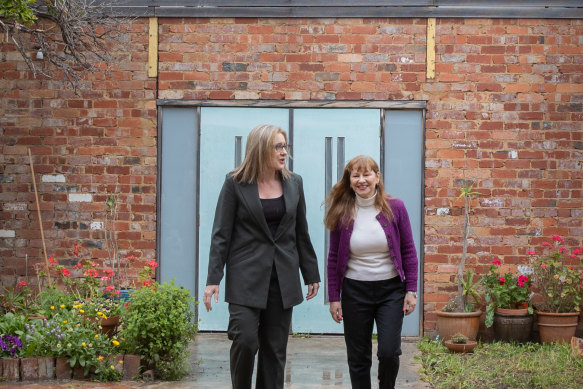
Save articles for later
Add articles to your saved list and come back to them any time.
The problem is plain to see for anyone trying to buy or rent a home in Melbourne. Just this week, the housing crisis was laid bare by the National Shelter and SGS Economics annual affordability index, which showed trying to find an affordable home to rent within 15 kilometres of the CBD had become all but impossible.
Governments have spent years articulating the problem while offering few solutions. A week before Daniel Andrews bowed out as Victoria’s premier, in his last major policy statement, Labor revealed its most extensive overhaul of the state’s planning rules. Its big-picture objective is to kick-start an increase in supply of housing by streamlining and fast-tracking the approval process needed for construction.
Premier Jacinta Allan at the home of Brunswick West resident Helen Politis on Tuesday. The premier was spruiking the granny flat changes.Credit: Simon Schluter
One of Labor’s key changes was the stripping away of restrictions on the building of granny flats that can be put in people’s backyards. The new rules mean a granny flat under 60 square metres will no longer need the planning stamp of approval from a local council, instead just needing a building permit.
Before that change, Victoria had some of the nation’s toughest regulations on granny flats. Although it varied from council to council, those wanting to build a small home in their backyard typically had to prove the future occupant was a dependent person, such as a teenager or disabled elderly parent. If the person died or moved out, the flat would have to be removed.
Victoria only had to look to its northern border to see the impact the changes could have. In 2009, NSW brought in legislation that streamlined the planning rules around granny flats. It led to a boom in construction.
Just a few years after the planning rules were changed, there was a threefold increase in the number of granny flats being built. In 2021, the federal government bolstered the sector by removing the capital gains tax liability from the creation, variation and termination of a granny flat.
But no change comes without resistance. And it should hardly surprise anyone that a Melbourne council, whose planning powers have been curtailed, would be leading the charge in opposition to the planning overhaul.
Eleven councillors from the City of Boroondara put out a heated statement declaring that giving residents the right to build granny flats without a planning permit rides roughshod over community concerns, will erode neighbourhood character and spark parking chaos.
In one respect, the council is in the eye of the storm. Labor identified Camberwell Junction, which is within the council’s boundaries, as one of 10 suburban activity centres where it wants to turbocharge construction, with an ambitious target of building an extra 60,000 homes in these centres during the next decade.
Boroondara senior planning officer Mikaela Carter told a council meeting these reforms continue a trend in recent years of concentrating planning powers with the minister for planning while removing the role of local councils and communities in decision-making on planning issues. That is true. And for good reason, even if there are clear risks to be managed in the concentration of that power in a minister’s pen.
For many people, dealing with their local council to get the green light for building a home is a drawn-out bureaucratic nightmare.
On Wednesday, the state’s ombudsman put out a scathing report detailing how two councils entangled a woman in red tape for years after she built a small separate dwelling at the back of her home for her son, who required a dialysis machine to keep him alive.
There is no getting around the fact Melbourne needs to increase the speed with which houses are built. And if we are to ensure more housing does not just mean more urban sprawl, then small, low-impact housing such as granny flats built in suburbs with established infrastructure seems a sensible part of the solution.
Local councils must accept that for that to happen, the move to diminish their planning powers is the right one.
Patrick Elligett sends an exclusive newsletter to subscribers each week. Sign up to receive his Note from the Editor.
Most Viewed in National
From our partners
Source: Read Full Article
